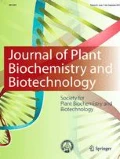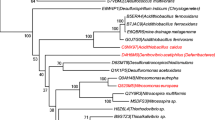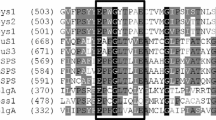Abstract
Sucrose is an important storage form of assimilated carbon in many plant species. Unlike other sucrose biosynthetic enzymes, Sucrose Phosphate Phosphatase (SPP), the terminal enzyme in sucrose biosynthetic pathway, is the least understood. SPPs from different organisms have different kinetic properties. The current study focuses on the structural differences among SPP homologues and unveils the probable structural basis of kinetic variations. We have employed computational methods of molecular modeling and structure comparisons and identified structural variations in some of the substrate binding residues, amino acid substitutions in regions that are lining the active site and minute structural differences that can enhance the nucleophilicity of a catalytic nucleophile (Asp 9 ). We report a structurally and hence functionally important amino acid substitution (Asp 159 by Alanine) in one of the rice SPP isoforms, which can result in the disruption of a H-bond that helps in binding of sucrose at the active site of the enzyme. In this paper we discuss the structural basis of enhanced catalytic efficiency of rice SPP in comparison with a cyanobacterium (Anabaena variabilis). The natural mutations identified in our analysis of the SPP catalytic domain would be useful in re-designing the enzyme for enhanced catalytic efficiency and higher sucrose production.





Similar content being viewed by others
Abbreviations
- SPP:
-
Sucrose phosphate Phosphatase
- SPS:
-
Sucrose phosphate Synthase
- HAD:
-
Halo Acid Dehydrogenase
- PSI-BLAST:
-
Position Specific Iterative BLAST
- GDT:
-
Global Distance Test
- MSA:
-
Multiple Sequence Alignment
- LGA:
-
Local Global Alignment
References
Aravind L, Galperin MY, Koonin EV (1998) The catalytic domain of the P-type ATPase has the haloacid dehalogenase fold. Trends Biochem Sci 23:127–129
Blumwald E, Tel-or E (1982) Osmoregulation and cell composition in salt-adaptation of Nostoc niuscorum. Arch Microbiol 132:168–172
Cumino A, Curatti L, Giarrocco L, Salerno GL (2002) Sucrose metabolism: anabaena sucrose-phosphate synthase and sucrose-phosphate phosphatase define minimal functional domains shuffled during evolution. FEBS Lett 517(1–3):19–23
DeLano WL (2002) The PyMOL Molecular Graphics System. DeLano Scientific, Palo Alto, http://www.pymol.org
Eccheverria E, Salvucci ME, Gonzalez P, Paris P, Salerno G (1997) Physical and kinetic evidence for an association between sucrose-phosphate synthase and sucrose-phosphate phosphatase. Plant Physiol 115:223–227
Eisenberg D, Lüthy R, Bowie JU (1997) VERIFY3D: assessment of protein models with three-dimensional profiles. Methods Enzymol 277:396–404
Erdmann N (1983) Organic osmoregulatory solutes in blue-green algae. J Plant Physiol 110:147–155
Fieulaine S, Lunn JE, Borel F, Ferrer JL (2005) The structure of a cyanobacterial sucrose-phosphatase reveals the sugar tongs that release free sucrose in the cell. Plant Cell 17(7):2049–2058
Giaquinta RT (1979) Sucrose translocation and storage in the sugar beet. Plant Physiol 63:828–832
Glasziou KT, Gayler KR (1972) Storage of sugars in stalks of sugar cane. Bot Rev 38(4):471–490
Hawker JS, Smith GM (1984) Occurrence of sucrose phosphatase in vascular and non-vascular plants. Phytochemistry 23:245–249
Huber SC, Huber JL (1996) Role and regulation of sucrose-phosphate synthase in higher plants. Annu Rev Plant Physiol Plant Mol Biol 47:431–444
Jayashree B, Pradeep R, Kumar A, Gopal B (2008) Correlation between the sucrose synthase protein subfamilies, variations in structure and expression in stress-derived expressed sequence tag datasets. J Proteomics Bioinform 1(8):408–423
Lunn JE (2003) Sucrose-phosphatase gene families in plants. Gene 303:187–196
Lunn et al (2000) Purification, molecular cloning, and sequence analysis of sucrose-6F-phosphate phosphohydrolase from plants. Proc Natl Acad Sci USA 97:12914–12919
Maiti et al (2004) SuperPose : a simple server for sophisticated structural superposition. Nucleic Acids Res 32:W47–w54
Makde et al (2006) Protein engineering of class-A non-specific acid phosphatase (PhoN) of Salmonella typhimurium: Modulation of the pH-activity profile. Biomol Eng 23(5):247–251
Muñoz FJ, Baroja-Fernández E, Morán-Zorzano MT, Viale AM, Etxeberria E, Alonso-Casajús N, Pozueta-Romero J (2005) Sucrose synthase controls both intracellular ADP Glucose levels and transitory starch biosynthesis in source leaves. Plant Cell Physiol 46(8):1366–1376
Nicholas KB, Nicholas HB Jr, Deerfield DW II (1997) GeneDoc: Analysis and Visualization of Genetic Variation, EMBNEW.NEWS http://www.psc.edu/biomed/genedoc
Salerno GL, Echeverria E, Pontis HG (1996) Activation of sucrose-phosphate synthase by a protein factor/sucrose-phosphate phosphatase. Cell Mol Biol 42:665–672
Sali A, Blundell TL (1993) Comparative protein modelling by satisfaction of spatial restraints. J Mol Biol 234:779–815
Schomburg et al (2002) BRENDA: a resource for enzyme data and metabolic information. Trends Biochem Sci 27(1):54–56
Thompson et al (1994) CLUSTAL W: improving the sensitivity of progressive multiple sequence alignments through sequence weighting, position specific gap penalties and weight matrix choice. Nucl Acids Res 22:4673–4680
Vriend G (1990) WHAT IF: a molecular modeling and drug design program. J Mol Graph 8:52–56
Warr SRC, Reed RH, Stewartw DP (1984) Physiological responses of Nodularia harveyana to osmotic stress. Mar Biol 79:21–26
Waterhouse AM, Procter JB, Martin DM, Clamp M, Barton GJ (2009) Jalview Version 2-A multiple sequence alignment editor and analysis workbench. Bioinformatics 25(9):1189–1191
Zemla A (2003) LGA: A method for finding 3D similarities in protein structures. Nucleic Acids Res 31(13):3370–3374
Acknowledgments
Authors thank Sugarcane Breeding Institute, Coimbatore for infrastructure facilities. DPS and NS are supported by Indian Council of Agricultural Research.
Author information
Authors and Affiliations
Corresponding author
Rights and permissions
About this article
Cite this article
Syamaladevi, D.P., Jayaraman, N. & Subramonian, N. Structural basis of kinetic variations in Sucrose Phosphate Phosphatase (SPP) of rice and Anabaena unveiled through computational analysis. J. Plant Biochem. Biotechnol. 23, 358–365 (2014). https://doi.org/10.1007/s13562-013-0219-5
Received:
Accepted:
Published:
Issue Date:
DOI: https://doi.org/10.1007/s13562-013-0219-5




